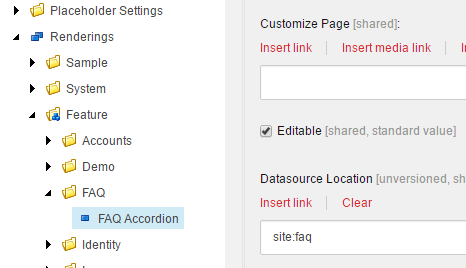2.6.3. Datasource settings¶
Renderings are defined in the feature layer, but they reference elements in the project layer, such as Page Type Templates, Datasource Templates and locations within the content tree. These references can result in dependencies that go the wrong way, or dependencies that cross features.
When dealing with datasource locations and datasource templates, Sitecore offers limited help in overcoming these dependencies – and therefore, to preserve the stringency of the architecture, you will have to introduce custom logic to overcome this limitation, typically by introducing a Foundation module (See Layers).
2.6.3.1. Datasource Template¶
The Datasource Template field in Editing Options section of the rendering’s item has two functions: it controls which types of items are allowed as datasource items for the rendering, and it designates the template used for new items created through the datasource dialog.
The Datasource Template field supports template inheritance. This means that you can select an item based on the specified template, or an item based on a template that derives from the specified template. This is very useful since a rendering in a Feature layer module most often relies on an Interface Template – which should be defined in the same Feature layer module (See Template types). The problem is, however, that Sitecore will use the specified template as the template for new items created through the Select the Associated Content dialog. This means that even though Sitecore supports it, you should not specify an Interface Template in the Datasource Template field, as you will end up with pages or datasource items based on this template – which ends up violating the architecture and create dependencies (see Dependencies).

Figure: Creating new content in the datasource dialog
Unless you plan to disable the opportunity to create new content in the Associated Content dialog or simply ignore the architectural principles and specify a Page Type or Datasource Template (see Template types) in the Datasource Template field, there is no easy solution for this conundrum. However, Sitecore does allow you to hook in to a pipeline to resolve the datasource template in context and thus be smarter around this. See the Habitat Example below.
2.6.3.2. Datasource Locations¶
The Datasource Location field in the Editor Options section of the rendering item allows you to specify one or more content locations from where the editors can select content for the rendering. More locations can be specified using a piped query: syntax.
The immediate challenge is that locations from which the renderings draw their content are often defined in the Project layer – by the sites themselves – and thus specifying the Datasource Location of the rendering will create a dependency from a feature rendering to a Project layer module. Furthermore, the challenges with specifying datasource locations can vary according to the complexity of your content architecture, for example if you are building a multi-site or even a multi-tenant solution where a rendering will have different locations depending of the context in which it is used.
A simple solution to this challenge is for the features themselves to own the datasource location itself. For example, a feature Teasers module could point to /sitecore/content/teasers as the datasource location for all its renderings, thereby forcing all sites to have a shared teasers repository. This will work perfectly fine for a simple single site/single tenant solution. But in other scenarios this might be challenged by the content governance model. Habitat provides an example.
Habitat Example
The Habitat example site is a true multi-tenant and multi-site solution. The Habitat project layer module, as well as our internally built product demonstrations, represent tenants (and sites) that define their own page types and datasource locations (see Multi-site and multi-tenant).
In order to accommodate this scenario, the datasource location and template resolution have been extended in the Habitat project. This means that it is also possible to define datasource templates and locations for each site, in addition to on the rendering itself. This is done through an extension of the getRenderingDatasource pipeline and the addition of a site: prefix to the Datasource Location field. In short: if the Datasource Location field contains a site: prefix, the pipeline extension will attempt to lookup the datasource location and template in a site specific list. This functionality is implemented in the Foundation.Multisite module.

Figure: Site specific datasource location for a FAQ rendering

Figure: The FAQ site specific datasource settings for Habitat